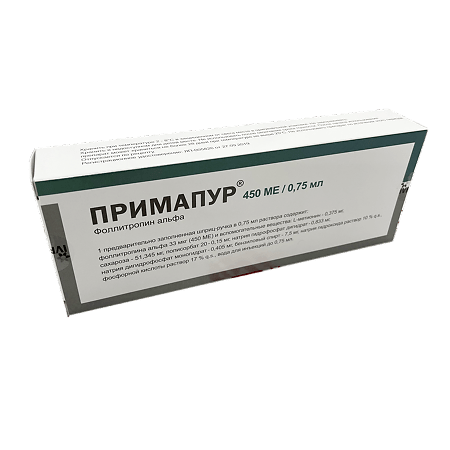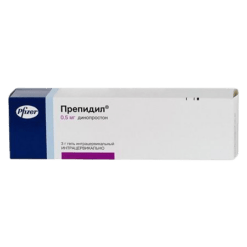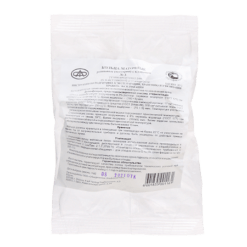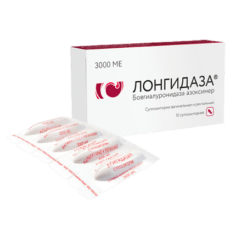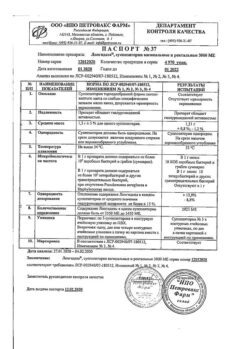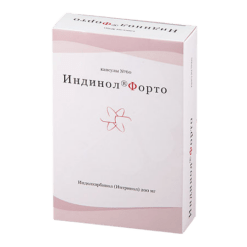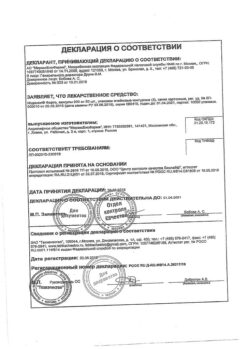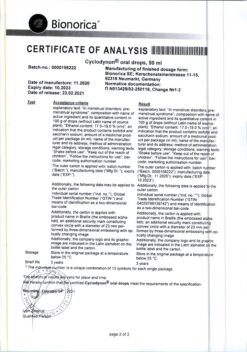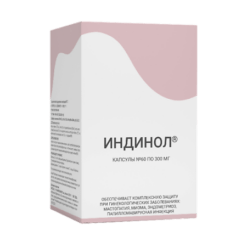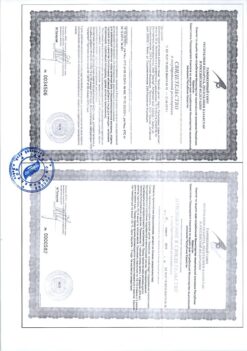No products in the cart.
Primapur, 33 mg/0.75 ml 0.75 ml syringe pen cartridges 1pc + needles 7 pcs
€1.00
Out of stock
(E-mail when Stock is available)
EAN: 4607069222440
SKU: 507181
Categories: Gynecology and Obstetrics, Infertility treatment IVF, Medicine
Description
Pharmacotherapeutic group:
The follicle stimulating drug.
ATX code: G03GA05
Pharmacological properties
Pharmacodynamics
Follitropin alfa is a recombinant human follicle stimulating hormone (hFSH). The drug is produced by recombinant DNA technology using Chinese Hamster Ovary (CHO) cell culture. Follitropin alfa has a gonadotropic effect: it stimulates follicle/follicle growth and maturation during ovulation induction (OI) and also promotes the development of multiple follicles during controlled superovulatory induction (CSI) in assisted reproductive technology (ART) programs.
In women with suppressed endogenous gonadotropin secretion, follitropin alpha has been shown to effectively stimulate follicle development and steroidogenesis despite low levels of luteinizing hormone (LH) not being available for measurement.
The use of follitropin alfa together with human chorionic gonadotropin (hCG) for 4 months in men with FSH deficiency induces spermatogenesis.
Pharmacokinetics
The absolute bioavailability is approximately 70% when injected subcutaneously. After repeated injections of Primapur® there is a threefold cumulation of follytropin alfa in blood in comparison to a single injection. Steady-state equilibrium concentration in blood is reached within 3-4 days. After intravenous administration, follitropin alfa is detected in extracellular fluids, with an initial elimination half-life of approximately 2 hours, while the final half-life is approximately 24 hours. The equilibrium volume of distribution is 10 l, with a total clearance of 0.6 l/h. 1/8 of the administered dose of follitropin alfa is excreted in the urine.
Indications
Indications
Active ingredient
Active ingredient
Composition
Composition
How to take, the dosage
How to take, the dosage
Primapur® is designed to be injected subcutaneously.
Primapur® treatment should be started under the supervision of a healthcare professional experienced in the treatment of infertility.
The first injection of Primapur® should be given under the supervision of the treating physician or qualified healthcare personnel. Self-injection can be done by well-motivated and trained patients who can get advice and guidance from a specialist.
It is recommended that the injection site be changed daily.
In women
The dose of Primapur® should be determined individually for each woman depending on ovarian response: by monitoring follicle size during ultrasound examination of the ovaries (ultrasound) and/or determining plasma estradiol concentrations.
Anovulation (including PCOS) in women if clomiphene therapy is ineffective.
Primapur® should be given as a course of daily injections. Treatment begins in the first 7 days of the cycle. Ovulation induction begins with a daily dose of 75-150 ME, increasing by 35-75 ME (if using a disposable syringe pen) or 37.5-75 ME (if using a vial), after 7-14 days until an adequate but not excessive response is obtained. The maximum daily injection dose should not exceed 225 ME.
After optimal follicle size is achieved 24-48 hours after the last Primapur® injection, an ovulation inducer, such as 250 µg of recombinant hCG or 5000-10000 ME of hCG, is injected once. The patient is advised to have sexual intercourse on the day of the ovulation inducer injection and the following day. Alternatively, intrauterine insemination may be performed.
If there is no positive trend after 4 weeks, treatment should be discontinued. For the next cycle the stimulation should be started with a higher dose of Primapur® than in the previous cycle.
If the ovaries respond excessively to stimulation treatment with folitropin alfa should be stopped, the ovulation inducer should be cancelled and precautions should be taken to prevent possible pregnancy to prevent multiple pregnancies. Stimulation should be repeated in the next cycle, starting with a lower dose of Primapur® compared to the previous cycle.
Controlled induction of superovulation in ART programs.
Primapur® is given daily in doses of 150-225 ME starting on the 2nd or 3rd day of a cycle. The daily dose may vary, but usually does not exceed 450 ME. Treatment is continued until follicles reach adequate size according to ultrasound data (5-20 days, on average by the 10th day of treatment). After 24-48 hours after the last Primapur® injection the ovulation inducer is administered once, e.g. 250 µg of recombinant hCG or 5000-10000 ME hCG for induction of final follicle maturation.
A gonadotropin-releasing hormone agonist or antagonist is used to suppress endogenous LH release and keep it low. In a typical protocol, Primapur® is started about two weeks after starting agonist treatment and then both products are continued until follicle size is adequate. For example, after two weeks of agonist treatment, 150-225 ME of Primapur® is given for 7 days. Thereafter, the dose is adjusted depending on the ovarian response. The available experience of ART suggests that the probability of successful treatment is generally maintained during the first 4 attempts and then gradually decreases.
In men
Stimulation of spermatogenesis in male hypogonadotropic hypogonadism (in combination with hCG).
Men usually receive Primapur® in a dose of 150 ME three times a week for at least 4 months in combination with hCG. If there is no positive effect during this time, treatment may be continued for up to 18 months.
Performance in Special Clinical Patient Groups
In adolescent girls less than 18 years of age
Primapur® is not indicated in adolescent girls less than 18 years of age.
In the elderly
The use of the drug is not indicated after the onset of menopause.
The safety and effectiveness of follitropin alfa in elderly patients has not been established.
In patients with renal impairment
The use of follitropin alfa in patients with renal impairment has not been studied.
In patients with hepatic impairment
The use of follitropin alfa in patients with hepatic impairment has not been studied.
Interaction
Interaction
Special Instructions
Special Instructions
Because folletropin alfa therapy may be accompanied by serious adverse reactions, Primapur® should only be prescribed by a specialist experienced in infertility treatment. The start of therapy must be preceded by an examination of the infertile couple, in particular, studies must be conducted to rule out hypothyroidism, adrenal insufficiency, hyperprolactinemia, hypothalamic-pituitary neoplasms, and appropriate therapy is prescribed if necessary.
The patency of the fallopian tubes should be evaluated in order to choose an ART method. Tubal obstruction should be excluded if the patient is not participating in an in vitro fertilization program.
In patients with porphyria, as well as if a relative has porphyria, close monitoring is required during follettropin alfa therapy.
If the condition worsens or if the first signs of this disease appear, discontinuation of therapy may be required.
In therapy with follitropin alfa, evaluation of the ovaries by ultrasound examination (ultrasound) both alone and in combination with determination of plasma estradiol concentrations is required.
The response to follicle-stimulating hormone administration may vary from patient to patient, so minimum effective doses should be used in both women and men.
Ovarian hyperstimulation syndrome (OHS)
OHS must be differentiated from uncomplicated ovarian enlargement. The clinical symptoms of OHS may appear with increasing severity. A significant increase in the size of the ovaries, a high concentration of sex hormones, increased vascular permeability leading to the accumulation of fluid in the abdominal, pleural and, less frequently, pericardial cavities are characteristic.
The following symptoms are most characteristic of severe SUI: abdominal pain and feeling of distention, marked increase in ovarian size, increased body weight, shortness of breath, oliguria, gastrointestinal symptoms (nausea, vomiting, diarrhea); hypovolemia, hemoconcentration, electrolyte imbalance, ascites, hemoperitonium, pleural effusion, hydrothorax, acute respiratory distress syndrome may occur. In very rare cases, severe SUI may be complicated by ovarian torsion and cases of thromboembolism, such as pulmonary embolism, ischemic stroke or myocardial infarction.
The risk of developing SGBV increases with HCG use. Therefore, if the ovaries respond excessively to stimulation, hCG is not administered and patients are advised to abstain from coitus for at least 4 days or use barrier contraception. SUI can progress rapidly (from days to days) to severe, so monitoring for at least two weeks after hCG injection is necessary.
In order to minimize the risk of SUI and multiple pregnancies, regular ultrasound and assessment of serum estradiol concentrations are used. With anovulation, the risk of SVF is increased when the estradiol concentration is >900 pg/mL (3300 pmol/L) and there are more than 3 follicles with a diameter of at least 14 mm. For HRT, the risk of SVF is increased when the estradiol concentration is >3000 pg/mL (11000 pmol/L) or there are 20 or more follicles with a diameter of 12 mm or more. When the estradiol concentration is 5,500 pg/mL (20,200 pmol/L) or when there are 40 or more follicles, hCG should be withheld.
Strict adherence to the recommended folletropin alfa dosing regimen, as well as close monitoring of therapy, minimizes the risk of SGH and multiple pregnancies.
The likelihood of SGH in patients undergoing controlled superovulatory induction in ART programs is reduced by aspirating all follicles.
In pregnancy, the severity of SVF can worsen and its duration can increase. The most frequent SGI occurs after discontinuation of hormonal therapy and reaches its maximum in 7-10 days. As a rule, mild to moderate SGN spontaneously resolves with the onset of menstruation.
In the development of severe SGN, gonadotropin therapy, if still ongoing, should be discontinued. The patient should be admitted to the hospital and given a SNF-specific therapy.
Patients with PCOS or high serum estradiol concentrations are at higher risk for SUF.
Multiple pregnancies and multiple births with ovulation induction are more common than with natural conception; twins are the most common variant in multiple pregnancy. A multiple pregnancy, especially with a large number of embryos, increases the risk of adverse outcomes for the mother and fetus. To minimize the risk of multiple pregnancies, careful monitoring of the ovarian response is necessary. With ART, the risk of multiple pregnancy is mainly related to the number of embryos transferred, their viability and the age of the patient.
Pregnancy failure
The incidence of pregnancy failure after ovulation induction and ART programs is higher than in the general population.
Ectopic pregnancy
Patients with a history of fallopian tube disease have an increased risk of ectopic pregnancy. The likelihood of ectopic pregnancy after ART is higher than in the general population.
There have been reports of benign and malignant neoplasms of the ovary and other reproductive organs in women after multiple courses of infertility treatment with different medications. Currently, no association between gonadotropin therapy and an increased risk of neoplasia in infertility has been established.
The incidence of congenital fetal anomalies after the use of ART programs may be slightly higher than in natural pregnancy and childbirth. However, it is unknown whether this is due to parental characteristics (e.g., maternal age, sperm quality) and multiple pregnancies or directly due to ART procedures.
Trombolytic complications
In patients with recent or ongoing thromboembolic disease, or a probable risk of such, gonadotropin use may increase this risk or complicate the course of these diseases. For patients in this group, the benefit of therapy must be weighed against the possible risk. It should be noted that pregnancy itself carries an increased risk of thromboembolic disorders.
Male treatment
Elevated serum follicle-stimulating hormone concentrations in men may indicate primary testicular insufficiency. In this case therapy with folletropin alfa is not effective, use of Primapur® is contraindicated.
4-6 months after the start of therapy it is recommended to perform spermatogenesis control.
Patients should be aware of the above risks before starting therapy.
The physician should be informed of all types of allergic reactions that the patient has, as well as any medications used before starting treatment with Follytropin alfa.
The use of follitropin alfa has no effect on driving and operating ability.
Contraindications
Contraindications
Hypersensitivity to follitropin alfa and/or any excipient of the drug.
Tumors of the pituitary gland or hypothalamus.
In women:
Primapur® should not be used if it is not possible to achieve the goal of therapy: in women with genital abnormalities and uterine fibroid incompatible with pregnancy, primary ovarian failure.
In men: in primary hypogonadism (primary testicular insufficiency).
In patients with porphyria, and in the presence of porphyria in relatives. In women with a history of or current thromboembolic disease, or in women at high risk of thromboembolic complications (presence of thrombosis or thromboembolism in immediate family members).
Side effects
Side effects
The following adverse reactions may occur with Primapur® (categorized into systemic organ classes by frequency of occurrence): Very frequent (â¥1/10), Frequent (â¥1/100 and < 1/10), Infrequent (â¥1/1000 and < 1/100), Rare (â¥1/10000 and < 1/1000), Very rare (< 1/10000, including single reports). The frequency of adverse reactions in each group is listed in descending order.
Performance of the immune system: very rare – mild to moderate systemic allergic reactions (skin redness, rash, facial swelling, urticaria, difficulty in breathing), development of severe allergic reactions, including anaphylactic reactions and shock.
Nervous system disorders: very often – headache.
Vascular disorders: very rare – thromboembolism, usually associated with ovarian hyperstimulation syndrome (OHSS).
Relatory system, thoracic and mediastinal disorders: very rare – in patients with bronchial asthma worsening of the course or exacerbation of the disease.
Gastrointestinal disorders: often – abdominal pain, heaviness, abdominal discomfort, nausea, vomiting, diarrhea.
Gender and mammary gland disorders: very common – ovarian cysts; common – mild to moderate degree SHG (including appropriate symptomatology); infrequent – severe form of SHG (including appropriate symptomatology); rare – complication of SHG (see “Special Indications. “Special indications”), ectopic pregnancy (in women with a history of fallopian tube disease), multiple pregnancies.
General disorders and disorders at the injection site: very often – reactions of mild/moderate severity at the injection site (pain, redness, bruising, swelling).
Man’s use
Immune system disorders: very rare – mild to moderate systemic allergic reactions (e.g., skin redness, rash, facial swelling, urticaria, difficulty breathing), development of severe allergic reactions, including anaphylactic reactions and shock.
Disorders of the respiratory system, thorax and mediastinum: very rarely – in patients with bronchial asthma worsening of the course or exacerbation of the disease.
General disorders and disorders at the injection site very often – mild/moderate reaction at the injection site (pain, redness, bruising, swelling).
Dermatological and subcutaneous tissue disorders: often – the appearance of acne (acne).
Genital and breast disorders: often – gynecomastia, varicocele.
Metabolic and nutrition disorders: often – weight gain.
In case of serious adverse reactions or adverse reactions not listed above, it is necessary to inform the attending physician.
Overdose
Overdose
Pregnancy use
Pregnancy use
Similarities
Similarities
Additional information
| Shelf life | 2 years. Do not use after the expiration date stated on the package. After starting to use the drug can be stored for no more than 28 days at a temperature not exceeding 25 ° C. Do not use the drug after that period. |
|---|---|
| Conditions of storage | Store at 2 – 8 ° C in a light-protected place in the original package. Do not freeze. Keep out of reach of children. |
| Manufacturer | Medsintez plant, Russia |
| Medication form | solution |
| Brand | Medsintez plant |
Related products
Gynecology and Obstetrics
Prepidil, intracervical gel 0.5 mg/3 g syringes with catheter
Gynecology and Obstetrics
Buy Primapur, 33 mg/0.75 ml 0.75 ml syringe pen cartridges 1pc + needles 7 pcs with delivery to USA, UK, Europe and over 120 other countries.

